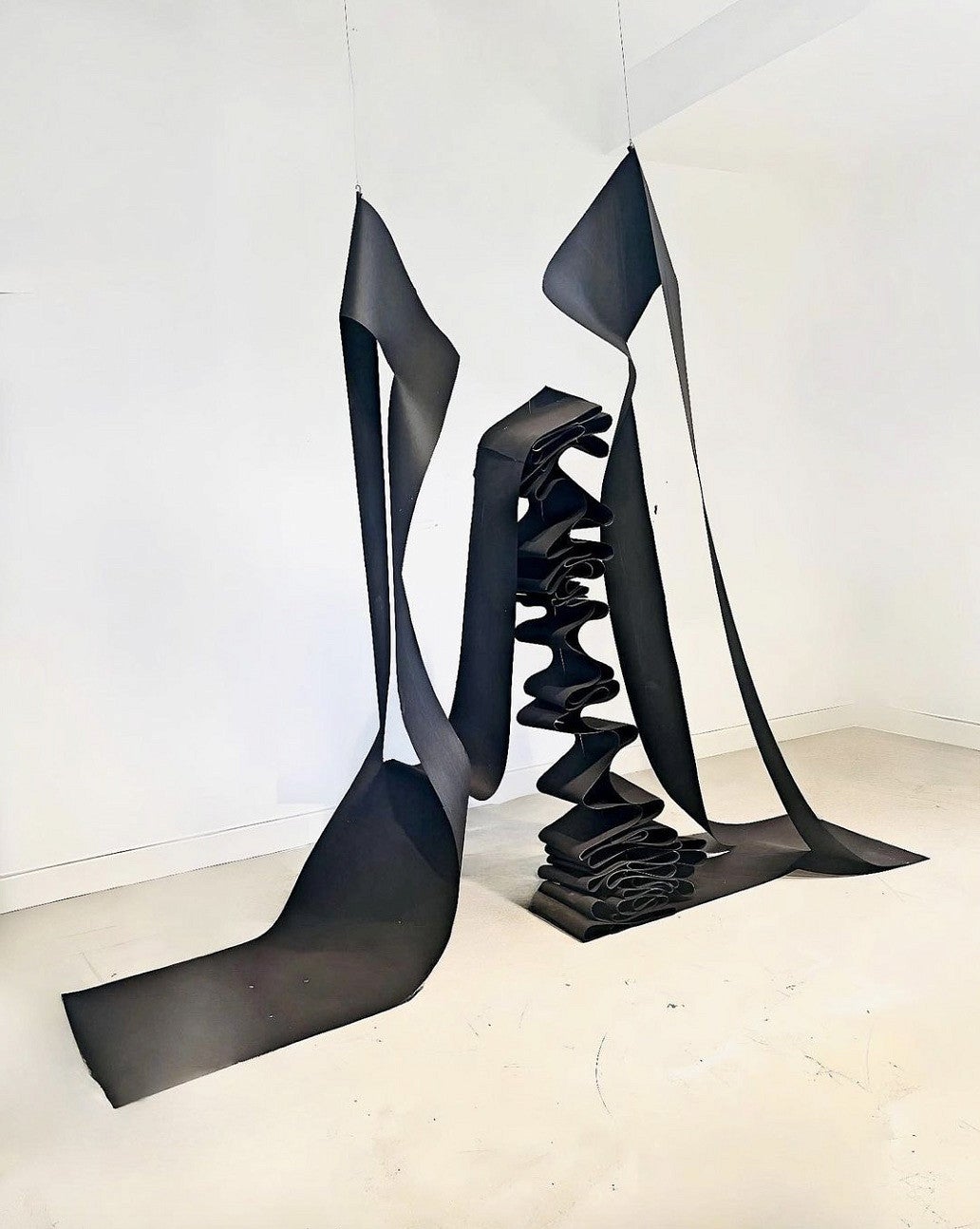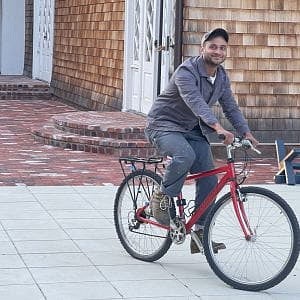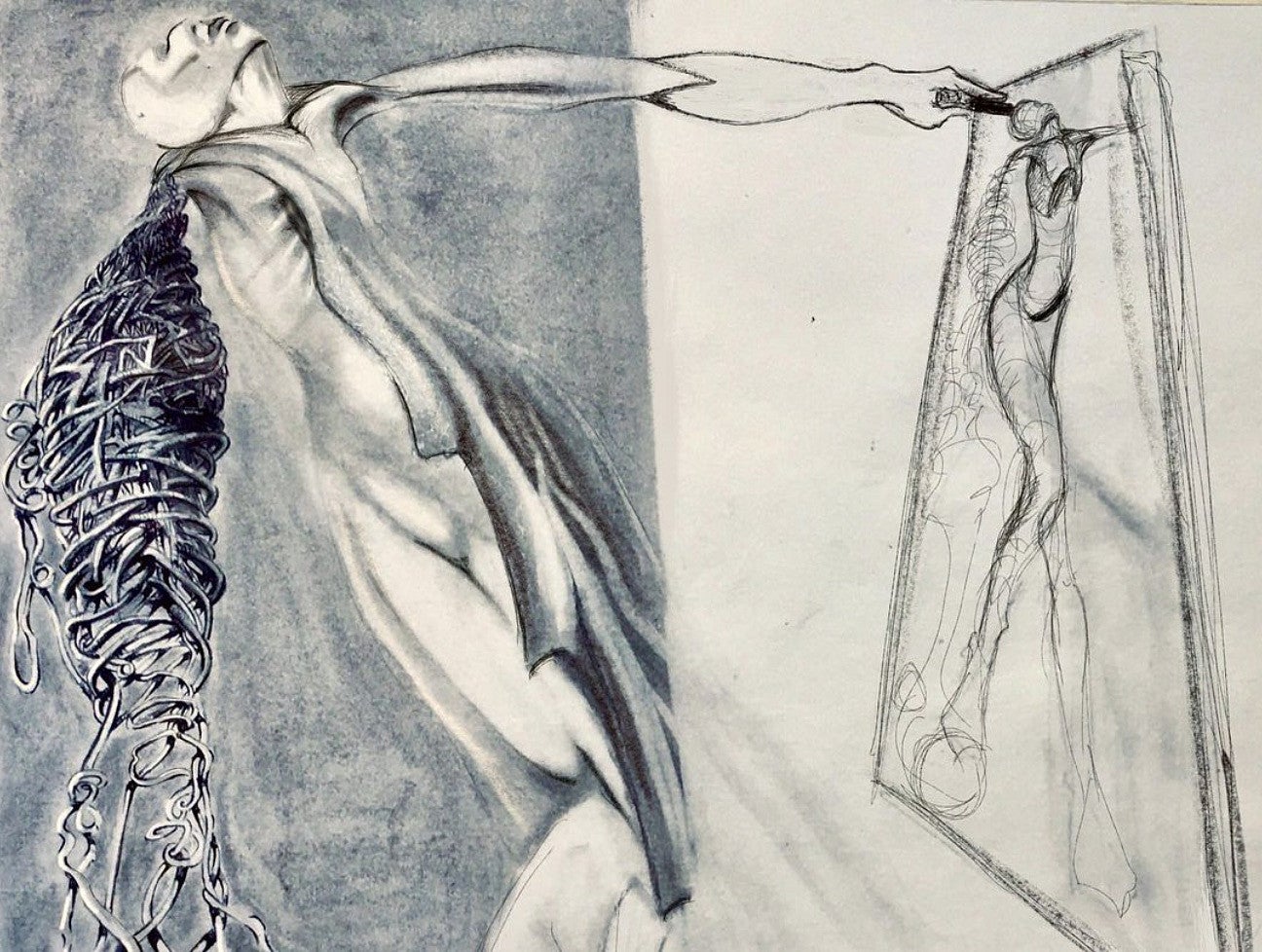
Abhishek Kulkarni, BFA ’24, came to the School of Art + Design with a slightly different background than most artists. Originally growing up in Bombay, India, Abhishek graduated with a bachelor's in biomedical engineering before coming to America for graduate school and a career in medical research.
“I came to Philadelphia in 2005 for graduate school and switched my focus to genetics and immunology,” explained Abhishek. “That’s what I was learning for many years while working at different biotechs, including Moderna, and conducting fundamental research related to sarcopenia, multiple sclerosis, and idiopathic fibrosis, among other topics.”
In his mind, Abhishek was firmly set on a career path that would fill his closet with lab coats and a report-filled inbox. While in Boston in 2018, Abhishek's wife received news that would create a coastal change of scenery and change their lives forever.
"My wife received a job offer here in Eugene in 2018. So for two years, we were going back and forth and that wasn’t fun at all. Around that time, I was thinking of a career change as well. I thought of applying to medical schools,” said Abhishek. “But I realized I needed to get a few premed credits to get an interview [into a medical program] since my bachelors is from India [and was under greater scrutiny here in the States]. So I decided to apply [to the University of Oregon] and Eugene to do the premed credits here, maybe take some art classes, because I was always interested in art, like a passion, but never got a chance to do it.”
Abhishek applied to the University of Oregon (UO) and began his term in earnest. He was eager to continue on his chosen career path.
“So I started and did my first term here trying to do all the premed classes,” explained Abhishek. "But then, I took one sculpture class just on a whim because I needed to register for a class and that was the only one open. I was like, ‘Let’s see what happens’ and the rest is history! Of course, none of this would be possible without the unwavering support of my wife!”
While Abhishek's plans changed suddenly from the regimented life of a day-to-day researcher to an artist, it wasn't a decision he made lightly or flippantly. Abhishek had been an artist his entire life. From a young age, Abhishek dedicated his free time to sketching, drawing, and painting. Art was primarily thought of as a hobby throughout his life and pursuit of undergraduate and graduate studies in biomedical sciences. The chance encounter with the sculpture class in the School of Art + Design (A+D) unlocked his passion and set Abhishek down a new path with his scientific experience as an additional lens for approaching his art.

"Having [now] taken classes with professors Tanaz Farsi, Amanda Wojick, and Sylvan Lionni, I am on my journey to learn a completely new and different language of art," said Abhishek. “End of the day I was just never happy in such a structured environment, but with sculpture, I feel like there's so much freedom and I can still do all the research because I love working with different materials. I feel like now I have an idea in my head and then all the research starts and then I can make whatever the hell I want. I feel at home in the studio.”
Abhishek found that his experience as a biomedical researcher helped him discover and shape his artistic process. A medical researcher's skills and scientific perspective are right at home in the rigorous artistic process, but with a degree of freedom not afforded to those who work in a medical lab for a Fortune 500 biotech company.
"I realized that I could apply the same research methodology which attracted me to science while having none of the constraints that are part of working in a research lab," explained Abhishek. "I realized that I could pursue art, which I previously thought of as a tool in my work, as the work! I would apply scientific rigor and methods to understand how different materials can be used but with the goal of creating new expression and meaning."
This freedom resonated deeply with Abhishek, who found comfort and familiarity with an A+D community that challenges and galvanizes its students to greater artistic heights and endeavors.
"Given my prior graduate training and long career in biotech research, I know I thrive in a challenging environment where I am required to manage several projects at the same time," explained Abhishek. "[A+D and its] community offers a rich environment where I can learn from faculty, who themselves are developing major exhibits within and outside UO, tackle new artistic endeavors with the support of faculty mentorship every week, and learn and grow from my peers, who have a different generational perspective than my own as a nontraditional, older student."
This challenging, inclusive environment has reinforced Abhishek's decision to switch fields and has allowed him to continue building his skills and finding his own way. Abhishek has experienced many "lightning bulb moments" or moments of divine inspiration or artistic creativity, but he is particularly fond of one moment. His first sculpture class.

"I feel like over the last three years there have been numerous lightning bolt moments of inspiration or creativity, but I can particularly remember the first one, because I feel like all sculpture one class has started with this one. They call it the foot project, where you're making a foot, you know? You make a mold, pour plaster, and then you have a foot,” exclaimed Abhishek. “[So in this class] I am working with the clay and plaster, like a kid, and I wondered if I should have felt like it should have felt like a step back in life, because I'm having to take [prerequisites again]. But as I was working with it, I was like 'Wow!' All of a sudden I felt like I was focused in a state of flow and making this shape and it is emerging out of nothing, you know? So when I [sculpted] that first time, I was like, wow, this is kinda incredible. Like here it is, you know, [an amphorous] 3D shape, and then all of a sudden something emerges from the materials. There was something very primal about it, too, working with clay and plaster. It was a crazy experience!"
As an older, nontraditional student, Abhishek’s educational success and experience are reinforced by support from the College of Design (DSGN) and its donors, specifically the David McCosh Memorial Scholarship in Fine Arts. Kulkarni earned this scholarship for the 2023 academic year and valued the support offered by the award.
"Sculpture is an expensive endeavor and while I generally tend to work off of cheap thrift store and construction materials, the costs build up really fast," said Abhishek. "I appreciate the value of this constraint as it pushes me to be creative with my resources and over the years I have developed a language that uses a lot of upcycling. This scholarship [award is] important as it allows me to develop this language further and makes it possible for nontraditional students, such as myself, to follow our dream in what is universally considered to be an unlucrative field of study. [Donor] support affords me the chance to bring my vision to life without compromising my integrity. [With this award] I can invest in recycled material and develop tools that further enable me to reduce the cost of production while still bringing my vision to life."

The David McCosh Memorial Scholarship in Fine Arts is one of the many opportunities for donors to support DSGN students and student success. One anonymous donor established this scholarship in 1986 to honor former UO faculty member David McCosh (1903–1980). McCosh taught printmaking, painting, and drawing at UO from 1934 to 1970. This scholarship supports outstanding undergraduate or graduate students in painting, drawing, printmaking, sculpture, or ceramics in the Department of Art, like Abhishek. This year's awardees include fourteen high-achieving students from the department. The college offers over 100 different scholarships to students both as a commitment to equity and recognition of student achievement. Abhishek's skills and achievements were further recognized by a prestigious art institution outside of A+D, specifically the Yale Norfolk School of Art.
The summer series is highly competitive, with only a handful of artists accepted to participate in a given year. Abhishek was a little skeptical of his chances of entering the program, at least at first.
“I did not think I would get in because it's a fairly competitive program and, if you ask me, my kryptonite is writing essays. I'm very confident with the toughest things you can tell me to do because I know one way or the other, I'll figure it out. But essay writing I cannot do,” said Abhishek. “So I did not expect to get in until they changed their prompt at the last moment. They decided to allow us the option of a video essay so I sent a clip of one of my stand-up performances. I was like 'If it works, it works!' and thankfully it worked! The question from the prompt was easy to incorporate into my [stand-up] act and felt very organic to what I was trying to do in my stand-up.”
Abhishek's video was well received by the committee, who believed that his novel approach elevated his application and resonated with the selection committee as a standout performance. Being chosen by the committee had a positive effect on Abhishek and was energizing.
“Honestly, [I would count this as] one of the best times of my entire life, I would say it was right after my wife said yes to my proposal or engagement, like a very close second moment. It was just, like, pure happiness, you know?” said Abhishek.
The 2023 Yale Norfolk School of Art Summer Series featured Byron Kim, Lisa Sigal, and Molly Zuckerman-Hartung as the resident faculty with an additional four teaching fellows as support. The Yale Norfolk School of Art was established in 1948 as an intensive six-week undergraduate summer residency program for 26 juniors/rising seniors. Kulkarni spent six weeks with twenty-five artists in a small estate in the northeast. Over those weeks, Abhishek learned from the best artists in the world without the chains of formality or complex social circles, or business representatives. The artists could immediately build relationships and rapport as everyone was just a person, albeit a highly motivated and professional individual, staying in a small cabin in the woods trying to better themselves. It was very freeing for Abhishek.

"We had small cabins with a studio that [Yale] gave us [for the summer]. I was with all of these just exceptionally motivated, professional, talented artists, fortunately there was one guy who was 35 so I had some company, but we were all just living our lives [during this time]," said Abhishek. "Take [Kim], one of the co-directors of the program. He was there with me [in the woods] and I was driving with him to go get groceries, you know? Right after I got back for the term, I read a paper on him in class! Just having the opportunity to spend time with them and seeing how these exceptionally famous and talented artists live their lives and how they approach their art was just an incredible learning experience. I felt like I learned so much from just absorbing, observing people, and watching them be themselves. Just being in the moment and really enjoying [it]."
Abhishek is set to graduate at the end of the academic year and plans to immediately continue his artistic journey with his upcoming residency with Skowhegan, where for two months he will delve deeply into his artistic process alongside other artists in rural Maine. For over seven decades, this extremely competitive program has been a catalyst for artists from all around the world to expand their thinking and experiment with their materials while broadening their perspectives on the world with the help of peers and faculty. Afterward, Abhishek will continue his artistic journey at the graduate level with possibly a trek into academia.
"I don't think I need to take a break at all because, I mean, I feel like I have seen the real world enough in life that I can jump into a graduate program. I would love to be a professor and a working artist," said Abhishek. "My greatest hope is to bring humor into contemporary art and want to thank Tanaz Farsi, Amanda Wojick, Sylvan Lionni, and Reanna Schultz for their support [throughout my undergrad journey]. Sounds cliche, I know, but I have learned that good art, while sometimes can happen quickly, mostly takes years of incubation and patience. Like a fine wine, it needs the right amount of aging. This is a lesson I am going to carry with me throughout my life and will be important to remember in today's age of quick gratification."
Learn More
